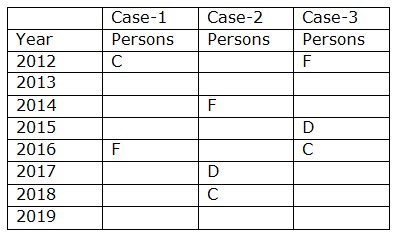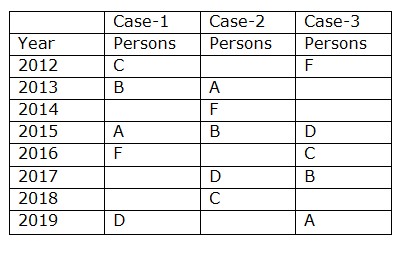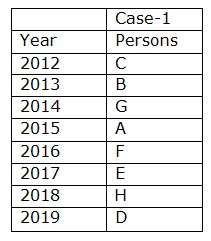Question
How many persons completed the training between G and
C? Study the following information carefully and answer the questions given below. Eight persons A, B, C, D, E, F, G and H completed Army training in eight different years viz. 2012 to 2019, but not necessarily in the same order. D completed the training three years after F. Only three persons completed the training between C and F. C doesn’t complete on an odd numbered year. The number of persons completed before D is one more than the number of persons completed after B. Only one person completed the training between B and A. The difference between the years in which G and E completed is three years. Both H and E completed the training in consecutive years.Solution
We have, D completed the training three years after F. Only three persons completed the training between C and F. C doesn’t complete on an odd numbered year. From the above condition, there are three possibilities  Again we have, The number of persons completed before D is one more than the number of persons completed after B. Only one person completed the training between B and A.
Again we have, The number of persons completed before D is one more than the number of persons completed after B. Only one person completed the training between B and A.  Again we have, The difference between the years in which G and E completed is three years. Both H and E completed the training in consecutive years. So Case2 and 3 get eliminated, hence the final arrangement becomes
Again we have, The difference between the years in which G and E completed is three years. Both H and E completed the training in consecutive years. So Case2 and 3 get eliminated, hence the final arrangement becomes 
State Bank of India has inked a memorandum of understanding (MOU) with the ________ Cooperative Milk Producers Union to provide loan to individual dairy...
निम्नलिखित में से कौन सा राजस्थान का राज्य पक्षी है ?
Who is the Chairman of the 16th Finance Commission?
“Hundi” is a –
Which number will come at the end of the number series?
13, 26, 39, 52, _____, 78
In the following question, select the odd number from the given alternatives.
When were the first Commonwealth Games held?
What is the theme of International Women's Day 2024?
Veteran freedom fighter, social reformer and feminist Savithribai Phule hailed from which of the following states of India?
How much did Union Bank of India commit to measure in terms of financed emissions through its signing of the PCAF in 2024?
Relevant for Exams:


